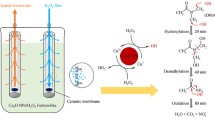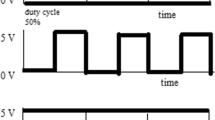Abstract
This work aims to integrate several hydrogen peroxide (H2O2) activation mechanisms, photolysis (UVC irradiation), chemical electron transfer (TiO2-P25 photocatalysis), and reaction with TiO2-P25 in dark conditions, for reactive oxygen species (ROS) generation towards the removal of contaminants of emerging concern (CECs), in a single unit operated in continuous-flow mode. An H2O2 stock solution is fed by the lumen side of a tubular ceramic membrane, delivering the oxidant to the (i) catalyst immobilized in the membrane shell-side and (ii) annular reaction zone (ARZ, space between membrane shell-side and outer quartz tube) where CECs contaminated water flows with a helix trajectory, being activated by UV light provided by four lamps placed symmetrically around the reactor. First, the effect of several parameters in the removal of a CEC target molecule, amoxicillin (AMX), was evaluated using a synthetic solution ([AMX]inlet = 2.0 mg L-1): (i) light source (UVA or UVC radiation), (ii) H2O2 dose, (iii) H2O2 injection method (radial permeation vs. upstream injection), and (iv) number of TiO2-P25 layers deposited on the membrane. The UVC/H2O2/TiO2 system with radial addition of H2O2 (20 mg L-1) and 9-TiO2-P25 layers provided the highest AMX removal efficiency (72.2 ± 0.5%) with a UV fluence of 45 mJ cm-2 (residence time of 4.6 s), due to the synergic effect of four mechanisms: (i) AMX photolysis, (ii) H2O2 photocleavage, (iii) TiO2-P25 photoactivation, and (iv) chemical reactions between H2O2 and TiO2-P25. The urban wastewater matrix showed a negative effect on AMX removal (~44%) due to the presence of ROS scavengers and light-filtering species.
Graphical abstract




Similar content being viewed by others
Data availability
All data generated or analyzed during this study are included in this article.
References
Anjali R, Shanthakumar S (2019) Insights on the current status of occurrence and removal of antibiotics in wastewater by advanced oxidation processes. J Environ Manag 246:51–62. https://doi.org/10.1016/j.jenvman.2019.05.090
Baeza C, Knappe DRU (2011) Transformation kinetics of biochemically active compounds in low-pressure UV photolysis and UV/H2O2 advanced oxidation processes. Water Res 45(15):4531–4543. https://doi.org/10.1016/j.watres.2011.05.039
Cai MJ, Lin YP (2016) Effects of effluent organic matter (EfOM) on the removal of emerging contaminants by ozonation. Chemosphere 151:332–338. https://doi.org/10.1016/j.chemosphere.2016.02.094
Carrera G, Vegué L, Ventura F, Hernández-Valencia A, Devesa R, Boleda MR (2019) Dioxanes and dioxolanes in source waters: occurrence, odor thresholds and behavior through upgraded conventional and advanced processes in a drinking water treatment plant. Water Res 156:404–413. https://doi.org/10.1016/j.watres.2019.03.026
Castellanos RM, Paulo Bassin J, Dezotti M, Boaventura RAR, Vilar VJP (2020) Tube-in-tube membrane reactor for heterogeneous TiO2 photocatalysis with radial addition of H2O2. Chem Eng J 395:124998. https://doi.org/10.1016/j.cej.2020.124998
Cataldo F (2014) Hydrogen peroxide photolysis with different UV light sources including a new UV-LED light source. Front Chem 23:99–110
Data, Ra, (2019). Amoxicillin market analysis, by infection type, route (oral, intravenous), form (tablets, capsule, suspensions, syrup, powder), distribution channels (hospitals pharmacies, retail pharmacies, online pharmacies, others), region, forecasts to 2026. .
de la Cruz N, Esquius L, Grandjean D, Magnet A, Tungler A, de Alencastro LF, Pulgarín C (2013) Degradation of emergent contaminants by UV, UV/H2O2 and neutral photo-Fenton at pilot scale in a domestic wastewater treatment plant. Water Res 47(15):5836–5845. https://doi.org/10.1016/j.watres.2013.07.005
Díaz-Angulo J, Cotillas S, Gomes AI, Miranda SM, Mueses M, Machuca-Martínez F, Rodrigo MA, Boaventura RAR, Vilar VJP (2021) A tube-in-tube membrane microreactor for tertiary treatment of urban wastewaters by photo-Fenton at neutral pH: a proof of concept. Chemosphere 263:128049. https://doi.org/10.1016/j.chemosphere.2020.128049
Elmolla ES, Chaudhuri M (2009) Degradation of the antibiotics amoxicillin, ampicillin and cloxacillin in aqueous solution by the photo-Fenton process. J Hazard Mater 172(2-3):1476–1481. https://doi.org/10.1016/j.jhazmat.2009.08.015
Elmolla ES, Chaudhuri M (2010) Photocatalytic degradation of amoxicillin, ampicillin and cloxacillin antibiotics in aqueous solution using UV/TiO2 and UV/H2O2/TiO2 photocatalysis. Desalination 252(1-3):46–52. https://doi.org/10.1016/j.desal.2009.11.003
Glaze WH, Kang J, Chapin D (1987) The chemistry of water treatment processes involving ozone, hydrogen peroxide and ultraviolet radiation. Ozone Sci Eng 9:335–352. https://doi.org/10.1080/01919518708552148
Gomes AI, Vilar VJP, Boaventura RAR (2009) Synthetic and natural waters disinfection using solar radiation in a pilot plant with CPCs. Catal Today 144:55–61. https://doi.org/10.1016/j.cattod.2008.12.023
Gomes AI, Soares TF, Silva TFCV, Boaventura RAR, Vilar VJP (2020) Ozone-driven processes for mature urban landfill leachate treatment: organic matter degradation, biodegradability enhancement and treatment costs for different reactors configuration. Sci Total Environ 724:138083. https://doi.org/10.1016/j.scitotenv.2020.138083
Huling SG, Pivetz BE (2006) In-situ chemical oxidation (No. EPA/600/R-06/072). Washington, DC
Huttner A, Bielicki J, Clements MN, Frimodt-Møller N, Muller AE, Paccaud J-P, Mouton JW (2019) Oral amoxicillin and amoxicillin–clavulanic acid: properties, indications and usage. Clin Microbiol Infect 26:871–879. https://doi.org/10.1016/j.cmi.2019.11.028
Ikehata K, Wang-Staley L, Qu X, Li Y (2016) Treatment of groundwater contaminated with 1,4-dioxane, tetrahydrofuran, and chlorinated volatile organic compounds using advanced oxidation processes. Ozone Sci Eng 38(6):413–424. https://doi.org/10.1080/01919512.2016.1198686
Li X, Chen C, Zhao J (2001) Mechanism of photodecomposition of H2O2 on TiO2 surfaces under visible light irradiation. Langmuir 17(13):4118–4122. https://doi.org/10.1021/la010035s
Li X, Shen T, Wang D, Yue X, Liu X, Yang Q, Cao J, Zheng W, Zeng G (2012) Photodegradation of amoxicillin by catalyzed Fe3+/H2O2 process. J Environ Sci 24(2):269–275
Liang X, Chen B, Nie X, Shi Z, Huang X, Li X (2013) The distribution and partitioning of common antibiotics in water and sediment of the Pearl River Estuary, South China. Chemosphere 92(11):1410–1416. https://doi.org/10.1016/j.chemosphere.2013.03.044
Liu W, Andrews SA, Stefan MI, Bolton JR (2003) Optimal methods for quenching H2O2 residuals prior to UFC testing. Water Res 37(15):3697–3703. https://doi.org/10.1016/S0043-1354(03)00264-1
Lofrano G, Pedrazzani R, Libralato G, Carotenuto M (2017) Advanced oxidation processes for antibiotics removal: a review. Curr Org Chem 21:1–14. https://doi.org/10.2174/1385272821666170103162813
Lumbaque EC, Sirtori C, Vilar VJP (2020) Heterogeneous photocatalytic degradation of pharmaceuticals in synthetic and real matrices using a tube-in-tube membrane reactor with radial addition of H2O2. Sci Total Environ 743:140629. https://doi.org/10.1016/j.scitotenv.2020.140629
Matamoros V, Arias CA, Nguyen LX, Salvadó V, Brix H (2012) Occurrence and behavior of emerging contaminants in surface water and a restored wetland. Chemosphere 88(9):1083–1089. https://doi.org/10.1016/j.chemosphere.2012.04.048
Morasch B, Bonvin F, Reiser H, Grandjean D, de Alencastro LF, Perazzolo C, Chèvre N, Kohn T (2010) Occurrence and fate of micropollutants in the Vidy Bay of Lake Geneva, Switzerland. Part II: micropollutant removal between wastewater and raw drinking water. Environ Toxicol Chem 29(8):1658–1668. https://doi.org/10.1002/etc.222
Moreira FC, Soler J, Alpendurada MF, Boaventura RAR, Brillas E, Vilar VJP (2016) Tertiary treatment of a municipal wastewater toward pharmaceuticals removal by chemical and electrochemical advanced oxidation processes. Water Res 105:251–263. https://doi.org/10.1016/j.watres.2016.08.036
Nogueira RFP, Oliveira MC, Paterlini WC (2005) Simple and fast spectrophotometric determination of H2O2 in photo-Fenton reactions using metavanadate. Talanta 66(1):86–91. https://doi.org/10.1016/j.talanta.2004.10.001
O’Brien M, Baxendale IR, Ley S v (2010) Flow ozonolysis using a semipermeable Teflon AF-2400 membrane to effect gas - liquid contact. Org Lett 12(7):1596–1598. https://doi.org/10.1021/ol100322t
O'Dowd K, Pillai SC (2020) Photo-Fenton disinfection at near neutral pH: process, parameter optimization and recent advances. J Environ Chem Eng 8(5):104063. https://doi.org/10.1016/j.jece.2020.104063
Olama N, Dehghani M, Malakootian M (2018) The removal of amoxicillin from aquatic solutions using the TiO2/UV-C nanophotocatalytic method doped with trivalent iron. Appl Water Sci 8(4):97. https://doi.org/10.1007/s13201-018-0733-7
Pignatello JJ, Oliveros E, MacKay A (2006) Advanced oxidation processes for organic contaminant destruction based on the Fenton reaction and related chemistry. Crit Rev Environ Sci Technol 36(1):1–84. https://doi.org/10.1080/10643380500326564
Ramírez-Franco JH, Galeano L-A, Vicente M-A (2019) Fly ash as photo-Fenton catalyst for the degradation of amoxicillin. J Environ Chem Eng 7(5):103274. https://doi.org/10.1016/j.jece.2019.103274
Rivas J, Gimeno O, Borralho T, Sagasti J (2011) UV-C and UV-C/peroxide elimination of selected pharmaceuticals in secondary effluents. Desalination 279(1-3):115–120. https://doi.org/10.1016/j.desal.2011.05.066
Salazar C, Contreras N, Mansilla HD, Yáñez J, Salazar R (2016) Electrochemical degradation of the antihypertensive losartan in aqueous medium by electro-oxidation with boron-doped diamond electrode. J Hazard Mater 319:84–92. https://doi.org/10.1016/j.jhazmat.2016.04.009
Sánchez LD, Taxt-Lamolle SFM, Hole EO, Krivokapić A, Sagstuen E, Haugen HJ (2013) TiO2 suspension exposed to H2O2 in ambient light or darkness: degradation of methylene blue and EPR evidence for radical oxygen species. Appl Catal B-Environ 142-143:662–667. https://doi.org/10.1016/j.apcatb.2013.05.017
Schneider J, Matsuoka M, Takeuchi M, Zhang J, Horiuchi Y, Anpo M, Bahnemann DW (2014) Understanding TiO2 photocatalysis: mechanisms and materials. Chem Rev 114:9919–9986. https://doi.org/10.1021/cr5001892
Serna-Galvis EA, Botero-Coy AM, Martínez-Pachón D, Moncayo-Lasso A, Ibáñez M, Hernández F, Torres-Palma RA (2021) Degradation of seventeen contaminants of emerging concern in municipal wastewater effluents by sonochemical advanced oxidation processes. Water Res 154:349–360. https://doi.org/10.1016/j.watres.2019.01.045
Sirtori C, Zapata A, Gernjak W, Malato S, Lopez A, Agüera A (2011) Solar photo-Fenton degradation of nalidixic acid in waters and wastewaters of different composition. Analytical assessment by LC-TOF-MS. Water Res 45(4):1736–1744. https://doi.org/10.1016/j.watres.2010.11.023
Snyder EM, Pleus RC, Snyder SA (2005) Pharmaceuticals and EDCS in the US water industry - an update. J Am Water Works Assoc 97(11):32–36
Stasinakis AS (2008) Use of selected advanced oxidation processes (AOPs) for wastewater treatment - a mini review. Glob Nest J 10(3):376–385
Szymański K, Morawski AW, Mozia S (2018) Effectiveness of treatment of secondary effluent from a municipal wastewater treatment plant in a photocatalytic membrane reactor and hybrid UV/H2O2 – ultrafiltration system. Chem Eng Process 125:318–324. https://doi.org/10.1016/j.cep.2017.11.015
Vilar VJP, Alfonso-Muniozguren P, Monteiro JP, Lee J, Miranda SM, Boaventura RAR (2020) Tube-in-tube membrane microreactor for photochemical UVC/H2O2 processes: a proof of concept. Chem Eng J 379:122341. https://doi.org/10.1016/j.cej.2019.122341
Zhang Q, Li C, Li T (2013) Rapid photocatalytic decolorization of methylene blue using high photon flux UV/TiO2/H2O2 process. Chem Eng J 217:407–413. https://doi.org/10.1016/J.CEJ.2012.11.106
Ziolli RL, Jardim WF (1998) Mecanismo de fotodegradação de compostos orgânicos catalisada por TiO2. Química Nova 21(3):319–325
Funding
The financial support of this work is acknowledged: (i) the Coordenação de Aperfeiçoamento de Pessoal de Nível Superior, from Brasil (CAPES), with Finance Code 001; (ii) Associate Laboratory LSRE-LCM (base funding, UIDB/50020/2020), by national funds through FCT/MCTES (PIDDAC); and (iii) Project NOR-WATER funded by INTERREG VA Spain-Portugal cooperation programme, Cross-Border North Portugal/Galiza Spain Cooperation Program (POCTEP). The authors also acknowledge Brazilian Agencies Capes (PROEX 0070041) and FAPERJ (reference E-26/202.994/2015). Reynel M. Castellanos acknowledges his scholarship (141666/2018-8) from CNPq (Brazil), and J. Diaz-Angulo thanks Colciencias-Colombia for her scholarships (647). Vítor J.P. Vilar acknowledges the FCT Individual Call to Scientific Employment Stimulus 2017 (CEECIND/01317/2017).
Author information
Authors and Affiliations
Contributions
The statement to specify the contribution of each co-author is as follows:
- Conceived and designed the experiments: Reynel M. Castellanos and Jennyfer Díaz-Angulo
- Performed the experiments: Reynel M. Castellanos and Jennyfer Días-Angulo
- Analyzed the data: Alexandre Diório, Reynel M. Castellanos, Jennyfer Días-Angulo, and Ana I. Gomes
- Contributed reagents/materials/funding: Rosângela Bergamasco, Marcelo Fernandes Vieira, Márcia Dezotti, Miguel Angel Mueses, Fiderman Machuca-Martinez, and Vítor J. P. Vilar
- Drafted or revised the manuscript: Alexandre Diório, Reynel M. Castellanos, Jennyfer Díaz-Angulo, Ana I. Gomes, Rosângela Bergamasco, Marcelo Fernandes Vieira, Márcia Dezotti, Miguel Angel Mueses, Fiderman Machuca-Martinez, and Vítor J. P. Vilar
Corresponding authors
Ethics declarations
Ethics approval and consent to participate
Not applicable.
Consent for publication
Not applicable.
Competing interests
The authors declare no competing interests.
Additional information
Responsible Editor: Philippe Garrigues
This manuscript describes an original work, has not been published before, and is not under consideration by any other journal.
Publisher’s note
Springer Nature remains neutral with regard to jurisdictional claims in published maps and institutional affiliations.
Highlights
- Low footprint membrane photoreactor able to activate H2O2 into ROS;
- The membrane acts as photocatalyst support and oxidant-catalyst/water contactor;
- H2O2 activation by energy, chemical electron transfer, and TiO2-H2O2 interaction;
Rights and permissions
About this article
Cite this article
Diório, A., Díaz-Angulo, J., Castellanos, R.M. et al. A tubular ceramic membrane coated with TiO2-P25 for radial addition of H2O2 towards AMX removal from synthetic solutions and secondary urban wastewater. Environ Sci Pollut Res 29, 42120–42129 (2022). https://doi.org/10.1007/s11356-021-14297-4
Received:
Accepted:
Published:
Issue Date:
DOI: https://doi.org/10.1007/s11356-021-14297-4




